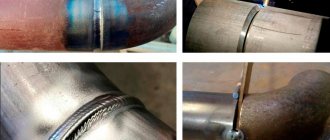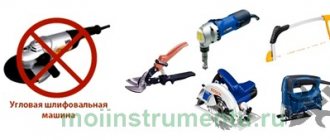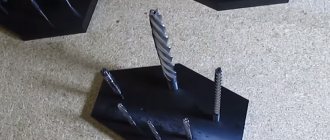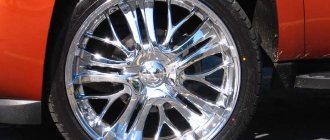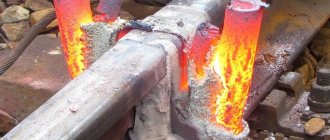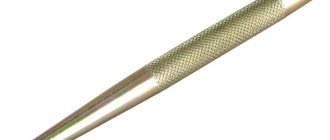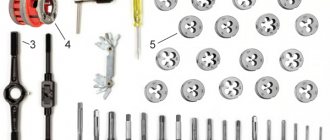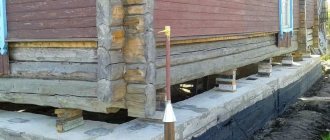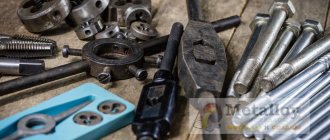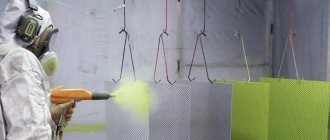Often, on the farm or during repairs, situations arise when a screwdriver is simply necessary. This hand-held power tool is designed for tightening and unscrewing various fasteners (screws, self-tapping screws, etc.).
Schematic diagram of a screwdriver.
Not every owner knows how to use a screwdriver, despite the high demand for this tool on the farm. There is nothing difficult in working with a screwdriver, however, to get the best results from using it, it is recommended to adhere to certain rules.
Features and types of instruments
The screwdriver can be battery-powered or mains-powered. The type of operation of the tool can be different; in this regard, it is customary to distinguish the following types:
- drill-driver;
- impact wrench;
- cordless screwdriver;
- ordinary screwdriver.
According to the type of work, screwdrivers are divided into several types: screwdriver, drill-driver, impact wrench and cordless screwdriver.
The operating principles of each of these tools are similar, the difference between them lies in the functions for which they are intended.
A drill-driver additionally allows you to drill a hole, while a regular one is intended only for working with fasteners. The impact wrench is designed to work with bolts and nuts, and the cordless screwdriver is designed to tighten and unscrew fasteners with Phillips heads. The last device has the lowest power of all.
A screwdriver is indispensable if you need to make a suspended ceiling, install drywall or sheet insulation. The absence of this device greatly complicates the work, during which it is necessary to tighten many screws or other fasteners. And in everyday life, when you need to screw in or unscrew one screw, doing this with a screwdriver is much more convenient and faster.
How to unlock a jammed screwdriver chuck
When the described problem occurs, a logical question arises about how to remove the drill from the screwdriver when the element is jammed.
At the first stage, professionals recommend pouring universal lubricant like WD-40 into the inside of the chuck (touching the surface of the cams). You can also use kerosene or machine oil instead. It is recommended to use such solutions in any case of jamming.
Jamming often occurs due to improper use
After 10-15 minutes, the cartridge and jaws must be carefully tapped through the gasket with a regular or rubber hammer. Typically, the grip loosens and the drill comes free.
If this does not happen, then you can slightly warm up the cartridge with a hairdryer and try to remove the bit again. The method is suitable for owners of screwdrivers with standard and quick-release fasteners.
You can also remove a jammed bit using two adjustable wrenches. After the lubricant is added inside, fairly simple steps are performed:
- The first key is used to compress the base of the cartridge,
- Second, carefully rotate the upper part.
It is recommended to place soft spacers between the parts so as not to damage them while they are being unscrewed.
Attention! In some cases, dealing with jamming is quite simple - it is necessary that the cartridge cools down well after work. As a result, the cams will open and the bit will come out easily.
There is another method by which you can cope with a similar problem. It is necessary to completely immerse the tool in a container with machine oil (even vegetable oil will do) or gasoline for one hour. After this period of time, remove the product and use the described methods to remove the bit from the clamp.
If you cannot carry out the procedure yourself, then it is better to contact a specialist so as not to damage the instrument.
There are several methods for removing the drill from the chuck.
Device setup and design features
The design of the tool is quite simple. The plastic housing houses a motor and a gear mechanism that drives a bit located at the end of the device. The design also includes a power switch, direction and speed switch, LED backlight, and tightening torque regulator.
Before using a screwdriver, you need to select an attachment for it that will correspond to the size of the head of the self-tapping screw or screw.
The operating principle of the tool is as simple as its design. The nozzle, fixed in the cartridge, is driven by a shaft, which begins to move from the engine through the gearbox. Before starting to work with a screwdriver, you need to check whether the battery is charged and whether the required attachment is installed.
To install the required nozzle, you need to select it according to the size of the head of the fastener and insert it into the magnetic holder of the cartridge. To do this, the cartridge and coupling must be removed from the device. After installing the required bit, the cartridge is reattached to the tool body.
Next you need to set the optimal bit rotation speed. This can be done using a special regulator. The required mode is set on the device being used before it is used. You can also switch the direction of the bit's movement.
Before using a screwdriver, you need to adjust the depth of screwing of the fastener. Over time, it may be necessary to replace the magnetic holder in the socket. To replace the magnetic holder, the cartridge and coupling, the magnetic holder are removed, and another is installed in its place. After this, the chuck with the coupling is installed back into the screwdriver body.
How to prepare for work?
The first thing you will need to do in order to get started is to remove the screwdriver from the case or suitcase and check for visible damage, chips or cracks. If you notice that there is something wrong with the tool, then under no circumstances should you use it, as this may be unsafe. Be sure to make sure that the screwdriver is charged, or that the screwdriver itself is connected to the mains. When these conditions are met, the screwdriver is turned on at idle speed and the rotation of the nozzle and the threads on the fastener are checked for compliance. If all conditions are met, then you can safely begin work.
Be sure to select and secure the correct bit or drill depending on where and how you plan to work. We mentioned how to secure them above when we talked about changing the nozzle.
When using the device directly, you must also follow a number of simple rules and requirements.
Pay close attention to the screwdriver itself. There is a special scale on it, by rotating which you can adjust the power of the tool.
When you turn the dial, set the mode you need, based on what kind of work you are currently doing.
- twisting;
- unscrewing;
- blocking
Switching between these tool capabilities is quite easy and simple. You just need to hold the screwdriver by the handle located above the battery. Most often, the handle is covered with a material that is rubberized. That is why such a processed handle is safe to use and guarantees that the screwdriver will not fall out of your hand while working. For greater reliability, the instrument is fastened to the hand using a strap.
Safety precautions when using a screwdriver
Use the tool only after making all necessary settings. To get started, you need to connect the device to the network or connect a battery to it. After this, you can turn on the screwdriver and perform the actions for which it is intended, that is, tighten or unscrew the fasteners. Compliance with operating rules allows you to extend the service life of the tool and get better results in a shorter time.
Adjusting the movement of the bit is strictly prohibited while the screwdriver is operating. Care must be taken to ensure that no moisture gets on the instrument or inside its body. It is strongly recommended to use the device only in sufficient lighting conditions. In addition, if the tool is networked, then the electrical network must operate without voltage drops.
Contact between the screwdriver and grounded objects is strictly prohibited. If this happens, the technician may receive an electric shock. Do not allow the device to overheat due to prolonged continuous operation. If the screwdriver is not allowed to rest, it may burn out. The instructions for the tool must be studied in detail before using it. You should not work with a screwdriver if any faults are detected in it.
It is advisable to wear special protective clothing while working.
Thus, despite the simplicity of the design and operating principle of the device, not every novice craftsman knows how to use a screwdriver correctly in order to extend its service life. Compliance with some simple operating rules will ensure the safety of the master, the safety of the device and the excellent quality of the result.
The screwdriver has successfully replaced not only various types of screwdrivers, but also wrenches and hex keys. This tool is also used instead of a drill. For builders and furniture makers, an electric screwdriver has become an indispensable assistant. There are always uses for it at home. The range on the market is represented by a wide variety of models. Despite the prevalence of screwdrivers in various fields of activity, not all users, especially beginners, know how to operate them. Proper use, maintenance and storage of power tools will maximize their service life.
Read also: Worm wheels made of bronze
Helpful operating tips
Let's get acquainted with some useful tips for using both conventional screwdrivers and tools such as a drill driver, using which you can use your tools for a long time and with high quality:
- if you are going to connect or remove the battery, be sure to turn off the screwdriver;
- during work, do not allow the tool to overheat, and at the slightest sign, take breaks from work;
- if you use a screwdriver at high speeds, then after that it is recommended to spin it at idle until it cools down;
- if the network is lost, the wire or cord of the charger must be replaced;
- Do not use it in rain, snow or any other wet environment.
- be sure to make sure that all parts of the device are in working order;
- if you have not used the tool for a long time, it is recommended to charge the battery, since even when not working, the battery is discharged;
- during the drilling procedure itself, be sure that there is no electrical cable, various pipes, and so on;
- just as when using a regular screwdriver , try to avoid getting moisture on the device body;
- When first used, the battery must be charged for at least 12 hours;
- When using directly, avoid frequently slowing down the device, otherwise you may damage the battery.
Do not forget about some features of storing a screwdriver . During storage, disconnect the battery from the device; it is recommended to store these components separately. After the battery is removed, it must be charged. Do not forget that if you do not use it for a long time, the batteries may discharge, so it is recommended to charge it periodically.
The screwdriver has a gearbox that requires lubrication. The frequency of this procedure depends on what model you are using and how often you use it. A warning that the device needs to be lubricated will be the appearance of a characteristic unpleasant hysterical sound, or heavy rotation of the cartridge. Silicone or Teflon grease, Litol or Mannol are good for lubrication.
To learn how to work with a screwdriver correctly, watch the video below.
Screwdriver design
What is a screwdriver? Basically, this is the same drill, but a screwdriver differs from it in that it has the lowest rotation speed of the chuck and, immediately, greater torque.
Another difference is that if on a drill the rotation speed changes smoothly, then on a screwdriver, usually, “fixed” rotation speeds of the chuck are set. This is due to the “slipping” function of the screwdriver chuck : when the self-tapping screw is tightened, the chuck stops spinning, although the engine is still running. This function allows you not to tear off the splines or even “drive” the self-tapping screw inside.
Different types of speeds are designed for specific jobs and materials, as well as the “drilling” mode. Just like a drill, a screwdriver has a reverse function. The design features of the screwdriver allow them to do a wide range of work: tightening and unscrewing self-tapping screws and screws, screws and nuts, drilling soft materials.
The introduction of a screwdriver , for example, in the production of plasterboard partitions or when assembling furniture, increases the speed of work with good results. Therefore, a screwdriver is actually considered the most common tool in any master’s kit.
The designs of all screwdrivers are approximately the same. They are quite light and have a “pistol” handle, designed for working with equipment with one hand.
Design and principle of operation of a screwdriver
According to the feeding method, screwdrivers are divided into two types:
- network, connected to networks with a voltage of 220 V;
- rechargeable batteries that use the energy of the accumulated charge.
Recently, instruments with a combined power supply have also appeared. They combine all the advantages of both varieties.
The external and internal design of network and battery models is almost the same. In general, a power tool consists of the following structural elements:
- housings;
- cartridge;
- power buttons;
- switch for the direction of rotation of the electric motor (reverse);
- speed controller (number of revolutions);
- power lock buttons;
- tightening force regulator (torque value switch).
The photo below shows the design of a cordless screwdriver.
A number of models are additionally equipped with lighting, which is structurally implemented in different ways. Not every product has a speed controller and a power lock button. Corded electric screwdrivers have a power cord, while cordless ones have a charge storage unit installed instead.
The body of a power tool is most often made of plastic, and much less often - of alloys of different metals. For convenience, it usually consists of 2 halves. Inside the case there are the following main parts:
- electric motor (DC or AC);
- pay;
- capacitor;
- gearbox;
- coupling
The electrical connections vary depending on the model.
An electric screwdriver can be equipped with different types of chucks. The most widely used is the quick-clamping three-jaw version of this part. The cartridge also consists of separate parts, which are shown in the photo below.
It should be taken into account that if the purpose of the screwdriver is highly specialized, then this may introduce some design changes.
The operating principle of both corded and cordless screwdrivers is the same. It consists in the fact that electrical energy drives an electric motor to rotate. Through the gearbox and shaft, force and speed are transmitted from the motor to the attachment fixed in the chuck. She is already drilling a hole or screwing or unscrewing fasteners. A peculiarity of the process is that the electric motor in network models operates at an alternating voltage of 220 V, and in battery-powered ones - at a constant voltage, the value of which can be in the range from 3.5 V to 36 V.
Cordless drill/driver
Cordless drill/driver Bosch PSR 18 Li-2.
A fairly simple screwdriver for home use, the main advantage of the device is a universal lithium battery, suitable for a jigsaw and delta grinder.
The weight of the screwdriver including the battery is 1.3 kg. That is, it is not heavy, but not light either. At the same time, the maximum torque is 46 Nm, which is not bad.
The speed is regulated, as in most other screwdrivers and drills - with a button. Also standard, there is a chuck rotation direction switch located nearby.
The screwdriver has a standard quick-release three-jaw chuck. The maximum diameter of the drill shank that can be clamped into this chuck is 10mm.
The manufacturer does not recommend using this screwdriver for drilling large holes: more than 10mm in steel, more than 35mm in wood.
To fix a bit or drill in the quick-release chuck of a screwdriver , just fix the chuck with your hand and turn on the screwdriver at high speed. And the chuck will clamp the drill itself.
To remove a drill or bit, you need to switch the screwdriver to reverse, lock the chuck and turn on the screwdriver: the cams will open and release the drill or bit.
The torque limiting clutch has become standard in screwdrivers. At the top of the case, opposite the cartridge, there is an arrow that indicates the number. The larger the number, the greater the torque the clutch can withstand without tripping. In total, the clutch has 10 positions with different torque settings, plus a drill mode. In drill mode? which is marked “DRILL”, the torque limiting clutch is disengaged. And with the help of a screwdriver you can already drill.
This screwdriver has two speed ranges from 0 - 400 rpm and from 0 - 1340 rpm. The speed can be switched using the red slide switch on the top of the screwdriver , in the “backward” position, the screwdriver operates at the first - low speed. If the engine is moved forward, the second speed is activated. In addition, the speed number can be seen in the window next to the switch.
A convenient option for a beginner is the direction of rotation indicator: two triangles at the top of the device will help you determine in which mode the screwdriver is operating: a forward arrow means that the chuck rotates clockwise and screws the screw accordingly; if the backward arrow lights up, the chuck rotates counterclockwise and turns out the screw.
The screwdriver has an indicator showing the charge level of the battery.
And nearby there is a “POWERLIGHT” backlight lamp, which will be a great help when working in poorly lit places.
We drill a wooden block in the “drill” mode, i.e. with the clutch disconnected. For a relatively thin drill, you can turn on the second speed.
To drive a screw, you need to select a bit that is suitable for this type of screw. The main types of splines, in the photo from left to right:
- 1)Philips,
- 2) positdrive,
- 3) straight,
- 4) star-shaped (torx),
- 5) hexagonal (hex).
In addition to the shape, the slots differ in size and for each slot size of a screw or screw, you need to take a bit of the right size.
So, the required bit is selected and clamped in the chuck, but to screw in the screw, you should turn on the first speed and set the clutch to limit the torque. In our case, for this diameter of screws we select position “17”.
The photo shows the result of screwing in a screw to different depths. When the screwdriver fully tightens the screw, the screwing force will increase and the torque limiting clutch will begin to operate. Thanks to this, the screw will not go deeper than necessary and will not split the block.
The lithium-ion batteries on which the battery is built are very good and you will not need to replace the batteries in the screwdriver for a long time.
- Selecting a screwdriver
- Cordless jigsaw
- DIY screwdriver battery repair
- Cordless delta grinder
Method 2
- Take the insulated wire and wind the spool in three rows onto the plastic tube.
- Insert the bat inside.
- Connect the ends of the wire to the battery terminals. If not, then take a battery. To enhance the effect, connect three or two batteries in series.
- Hold the bit inside the spool for a minute. Check the result.
Changing attachments
Changing the attachment on a screwdriver is not difficult. The tool can be equipped with a quick-release chuck or a key-type chuck. Replace the equipment in both cases in a similar way. To remove a drill from a screwdriver with a keyless chuck and insert a new one or another type of equipment, proceed as follows:
- first, select a bit according to the size of the head and the type of slot on it (cross, straight or other) or a drill of the required diameter corresponding to the material in which the hole is to be created;
- spin the cartridge counterclockwise;
- in the center, between the spread cams, install the selected type of equipment;
- Rotating the cartridge case in the direction of the clock hand, clamp the nozzle.
You can remove the drill bit from the screwdriver (or another attachment) by holding the moving part of the chuck with one hand and pressing the start button with the other. Just first switch the direction of rotation to unwinding.
When a drill-driver is equipped with a key chuck, then to change the equipment do this:
- inserting the key into the recess for it, unscrew the cartridge;
- I install the nozzle;
- clamp it by turning the key clockwise.
There are models in which you can remove one type of cartridge, for example, a quick-detachable one, and replace it with a turnkey analogue . When choosing any option, you need to focus not only on ease of use, but you should also consider the pros and cons of each of them. Thus, the key chuck securely clamps the equipment, which is important when drilling, and the quick-release chuck allows you to quickly replace it, even with one hand (the other holds the handle, pressing the start button as necessary).
Fastening device – non-combat cartridge
The chuck is the fastener in which the drill is fixed. The fastener itself is screwed onto the tool spindle. Most often, drills are equipped with a jaw chuck. This design is a hollow cylinder with metal “fingers” inside. When you turn the adjusting ring, which is located outside the assembly, the “fingers” converge or diverge along the inner cone-shaped surface. In such a “fist” you can clamp both a drill with a cylindrical shank and a hexagonal one.
Convenience and ease of use have made the cam mechanism popular. However, it is not without its drawbacks. One of them is the difficulty of working with small drills. A short product may simply fall inside. You can still secure it by placing the drill in a horizontal position, but you can’t put too much pressure on it while working. If another drill was inserted into the drill, you can remove it by turning the adjusting ring in the appropriate direction. It is not always possible to do this manually; for this purpose there is a special key that acts like a lever, increasing the force. By the way, it is also not recommended to tighten the drill without a key - the larger the diameter of the drill, the more reliable the fastening should be.
When purchasing fasteners, make sure that they are rubberized - this way you will be less likely to injure your hands when securing the tool.
The quick-release fastener, the second most popular, can be operated without a key. Simply insert the drill and turn the lever; this can often be done with one hand. The drill fixation that this type of chuck provides is quite sufficient for most jobs, however, compared to the classic fastening option, it is inferior in reliability and is more expensive. The main advantage of a quick-release fastener is the speed of drill replacement and the safety of the process, since such a chuck is devoid of teeth that can injure your hands. The absence of a specialized key is also a significant advantage! Experienced builders know how easily it gets lost, so very often you can see a key taped to a wire with tape or tape.
True, this does not add convenience, but there is at least some confidence that you won’t have to look for the key throughout the construction site. How to change the drill bit in a screwdriver? The scheme is absolutely identical - the chucks of most drills are similar to the fasteners on screwdrivers. Of course, the latter tool cannot be a full-fledged replacement for a high-quality drill, if only because the fasteners are not provided for drills with a large diameter, and the speed of a screwdriver is usually lower.
Scope of application of the screwdriver
Using a screwdriver correctly means performing only those operations specified in the operating instructions by the manufacturer of this product. The main types of work (by purpose) for this tool are:
- screwing in or unscrewing various types of fasteners, including tightening and loosening bolts and nuts;
- drilling holes in materials of different hardness.
Using a screwdriver for its intended purpose is the most common way to use this device, both at home and in construction, furniture production, electrical installation, car assembly and repair. The scope of application of the product is not limited to these areas: a drill-driver is useful wherever you need to work with fasteners (assemble and disassemble various structures, equipment, machines) and drill holes of relatively small sizes.
The scope of possible application of a particular model is determined by the category it belongs to: household or professional. A tool intended for home use is relatively cheap and has little power and torque. Household models have low performance and limited functionality.
A drill/driver from the professional category has advanced functionality and high technical performance. Such a tool is designed for long-term, effective use for its intended purpose. It also has much wider possibilities for unconventional exploitation.
Care and storage
- regularly disassemble and clean the internal elements of the screwdriver from carbon deposits, dust and dirt;
- If unstable operation occurs, carry out diagnostics. Check the wear of the brushes so that you do not have to change the motor armature;
- Do not leave the instrument in areas with high humidity or under the sun. The same goes for the battery;
- Do not keep the battery near keys, coins or other short metal objects. In case of accidental contact with the poles, the battery will short circuit. As a result, a fire may occur;
- At the end of the working day, take a clean rag and wipe the instrument. The cloth can be slightly moistened with water without using detergents;
- The screwdriver should be stored in a dry environment with positive temperatures. Use a case or other packaging to prevent the instrument from becoming covered in dust.
Operate a screwdriver, observing safety precautions and the rules described in the instructions. Choose the right equipment. And then the tool will serve you for a long time.
A screwdriver is a tool designed for tightening fasteners. If you have drills and special attachments, you can also perform some other operations with it.
Non-traditional use cases
In addition to its direct purpose, an electric screwdriver is used to perform various non-traditional operations. These include the following types of work:
- polishing the car and its headlights;
- mixing small volumes of various building mixtures and paints;
- drilling holes in ice (for this purpose the tool is equipped with a special attachment - a drill);
- binding of reinforcement;
- thread cutting;
- mowing the grass (for this purpose, convert the device into a trimmer or lawn mower, or simply insert an attachment with blades into the cartridge);
- chopping soft grass or thin branches (for this, a garden shredder is created based on a drill-driver);
- surface grinding;
- cutting materials;
- twisting of wires.
Read also: Cutting conditions when turning titanium
This is far from a complete list of non-traditional work performed using battery-powered or corded models of electric screwdrivers. Inventive thought does not stand still. Almost every specialist has options for work that is atypical for this power tool.
Using a screwdriver, you can return your car to its original color and shine. To polish a car, use the following types of attachments:
- leather or fabric circles, with their help they perform initial cleaning of surfaces;
- felt - they are used for initial processing and final polishing (nozzles made from sheepskin are suitable);
- foam rubber.
Polishing pastes and polishes are also used along with the equipment. They come in these types:
Using similar means, headlights are polished.
The quality of the achieved result is determined by the correct combination of attachments with polishing agents, as well as the accuracy and skill of performing the work.
Knitting reinforcing bars using steel wire is very common in the construction industry during the construction of reinforced concrete (monolithic) structures, for example, foundations and houses. Even if there is only a small amount of work to be done, working with a hand hook or pliers is quite unproductive. A cordless or corded electric screwdriver equipped with a hook attachment will help you knit reinforcement much faster. In this case, the power indicator of the tool is not particularly important.
Twisting the cut ends of wires, for example in junction boxes, is also a fairly routine job. You can speed up the process by using a screwdriver with a special attachment. How twisting is done is shown in the video below:
What is needed for hardening
To harden a bat you need nothing at all. First of all, you need to have the bat itself. You will also need motor oil, which is best poured into a small tin can (you can also use already used substance). You will definitely need a wire 30-40 cm long, a container with cold water and, most importantly, a gas burner or induction heater. When all this is prepared, you can get to work.
Separately, it should be added that it would not be superfluous to keep a “basic” set of tools on hand. This primarily applies to screwdrivers and pliers. You never know what you might need during such a serious event.
Features of drilling concrete, metal, brick with a screwdriver
Electric screwdrivers are used to drill wood, metal, concrete and other materials. At the same time, the functionality of the model used depends on its technical indicators: power, magnitude, torque, presence of shock operating mode, rotation speed. The operating instructions contain precise instructions on whether a particular material can be drilled with a screwdriver. It also provides the maximum diameter of the holes to be created, and in some cases, restrictions on depth.
Only a sufficiently powerful drill/driver can drill through a brick or concrete wall. In most cases, such devices can operate in shock mode. But drilling into a concrete wall with a screwdriver, even an impact type, is quite problematic. This tool is suitable for one-time operations only. This labor-intensive work is best done with a hammer drill.
In soft wood, even battery products from the household category are capable of creating holes with a cross-section of up to 20 mm. Using budget models from the rating of the best electric screwdrivers of 2017, various metals, including steel, are drilled. In this case, the diameter of the holes can reach 10 mm.
To drill each material, a specific type of drill is used. The nozzles differ not only in the material from which they are made, but also in their design and sharpening.
When working with a tool, the rotating drill must enter the surface of the material perpendicular to it - this allows you to evenly distribute the load on the equipment and create more accurate holes.
When drilling metal, it is recommended to first make a small depression in the center of the future hole using a core. This will prevent the drill bit from slipping on a smooth metal surface. If you need to make a hole with a sufficiently large diameter, you should first drill a smaller one. Also, when working with metal, it is recommended to regularly lubricate the nozzle with a special compound.
When using a drill-driver, you should keep in mind that you cannot apply strong pressure to it, because this will not only not speed up the work, but can also damage the drill, as well as the power tool itself. The effort must be constantly maintained at the same level. To avoid jamming or breaking the nozzle, you need to remove it from the drilled hole only when rotating. If the drill still gets stuck, you can get it out by reversing it.
It is recommended to drill small parts by first securing them in a vice. If you have to make a through hole in a thin sheet of metal or in a thin piece of wood, then you need to fit even pieces of plywood or boards under them.
Types of bits for a screwdriver: how to choose
To choose the right nozzles, you need to study their varieties. First determine the shank shape type and diameter. It ranges from 1/4 to 1 inch.
- basic;
- special;
- combined.
Types of main bits:
- splined. They differ in the width and thickness of the slot;
Spline bits of different widths and thicknesses
Types of special bits:
- tri wing or triangular;
Double pin have a notch
The drywall bit has a stop stop
Spring Lock Bit
Combination bits have two types of shank shapes or one, but of different sizes. For example, a splined shank and sprocket.
Example of a combination nozzle
Splined shank and sprocket
Determine the length of bit you need for the job. It ranges from 10 to 200 mm.
Depending on the shape of the shank, the nozzles have a certain marking:
- Sl (Slot) – splined;
- Ph (Philips) – cross-shaped universal;
- Pz (Poz >An important characteristic is the grade of steel from which the bat is made. The nozzle may have a protective coating. The strength of the equipment depends on this. The main types of steel and coatings that should be given preference:
- Cr-v - chrome vanadium steel. The most common, with increased hardness;
- Cr-Mb - chromium-molybdenum steel. Less common. Very durable material;
- Ni - nickel coating. Increases resistance to corrosion;
- WC - tungsten carbide coating. Increases strength;
- Tin - titanium nitrite yellow coating. Increases strength.
Tin - coating for increased strength
Nozzles vary depending on the purpose:
- twisting and unscrewing;
- drilling;
- riveting;
- polishing;
- milling.
Considering all the parameters considered, you can easily select the necessary bits.
Recommendations for proper instrument care
Both battery-powered and mains-powered models require periodic maintenance and ongoing care. Together with proper storage and the absence of operational overloads, these factors can extend the life of the screwdriver.
Quality care consists of the following:
- Do not let water get on the instrument. Therefore, the product should be stored in a specially designated, dry place.
- It is forbidden to throw the electric screwdriver.
- You should not overload the power tool: you can focus partly on heating the body. Only sharp drills should be used.
- The chuck must be lubricated periodically: the frequency of this activity is indicated in the operating instructions.
- If dirt, dust, adhering chips and other contaminants get in, they should be removed with a dry cloth (especially be careful with fuels and lubricants). You should also wipe down the device you are using at the end of the working day. The equipment must also always be in a clean condition.
- Batteries should be stored so that there is no short circuit between their terminals. The drives must not be deformed or left under direct sunlight.
- It is recommended to store lithium-ion batteries half charged from the maximum capacity, nickel-metal hydride batteries - fully charged, nickel-cadmium batteries - partially discharged (but only slightly).
- Nickel-cadmium drives after storage (or new ones) should be subjected to 3 full charge/discharge cycles before use so that they retain their capacity, and nickel-metal hydride – 4-5.
- Manufacturers recommend storing and operating electric screwdrivers at temperatures from -5 to +30 degrees.
- The charger for battery models must be turned off after charging the batteries to avoid overheating.
- Before and after work, it is recommended to check the integrity of the product being used, especially its moving parts.
- When drilling, it is recommended to periodically cool the bit using various methods.
Read also: 24 volt soldering iron regulator with thermocouple
Compliance with the given care recommendations does not take much time, but it helps to significantly extend the life of the product.
Before you start using a new screwdriver, it is recommended that you first read the operating instructions for it from the manufacturer. It already indicates the design features of the model, its technical characteristics, suitable area of application, frequency of maintenance, recommendations for transportation and storage. There are also safety rules that must be followed.
If, while working with the tool, there is a smell of melting plastic or insulation, smoke, uncharacteristic noise, or excessive vibration, then you should immediately stop using it.
When a product is under warranty, it is better to take it to a service center. Otherwise, you can try to repair it yourself.
It often happens that you can’t do without a screwdriver. A screwdriver is an indispensable assistant in the manufacture of suspended ceilings and installation of drywall. Repair work becomes more complicated if you don’t have a screwdriver on hand that can easily tighten screws and fasteners. In the domestic sphere it is in demand no less than in professional activities.
However, not all tool owners know how to use a screwdriver correctly. There is nothing difficult about this, the main thing is to adhere to some rules and recommendations for beginners.
Why can a bit get stuck in a screwdriver?
Whether the tool is expensive or cheap, jamming of the clamping device is not uncommon. This happens in several cases:
- When you try to use a drill of the largest allowable size, the chuck jaws are moved to the maximum value, after which it is often impossible to compress them normally.
- A jammed drill or bit cannot be removed because the jaws cannot be opened - in most cases due to their uneven compression.
- The jaws may jam due to free movement during compression and expansion. This is due to debris, shavings, and scale that have gotten inside and fall under the shaped parts of the cams.
Unfortunately, in such situations it is impossible to work with a screwdriver, despite its working order. You can cope with the problem yourself; in severe cases, it is better to contact a specialist service center.
Types of instruments: characteristic features
Screwdrivers can be classified into the following types:
- Drill/driver
- Impact wrench
- Cordless screwdriver
- Standard screwdriver
The operating principle of the tools is similar to each other, but there are still differences in functionality.
A drill-driver can not only tighten a screw, but also drill a hole. The impact wrench specializes in bolts and nuts. The third representative is a cordless screwdriver, designed exclusively for screwing/unscrewing fastening elements with a cross-shaped head. The latter type is characterized by low power, unlike the above.
Can a drill be used as a screwdriver?
A screwdriver can also be used as a drill. The chuck mechanism makes it possible to firmly fix a drill with a cylindrical shank. To get started, you will need to install a drill in the chuck.
Be careful, as the design is not designed for making holes, especially for hard wood, metal or concrete, because there is a high probability of the planetary gearbox breaking.
What does a screwdriver consist of? Device setup.
The plastic case contains a motor and a gear mechanism that drives the bit, which is installed at the end of the screwdriver. The device is equipped with a start toggle switch, a direction and speed switch, LED backlighting and a tightening time regulator.
The operating principle of the tool is very simple. The nozzle, previously fixed in the cartridge, moves with the help of a shaft, which begins to move from the operation of the motor through a gearbox. Before using a screwdriver, you should find out whether the battery is charged and whether the correct attachment is installed.
Immediately before performing the work, you need to look for a nozzle so that it matches the head of the self-tapping screw or screw.
To install the required nozzle, you should select it according to the size of the head of the fastener element and secure it in the magnetic holder of the cartridge. First, the chuck with the coupling must be removed from the device, and after fixing the bit, the chuck must again be secured to the screwdriver body.
Then you need to assign a suitable bit speed. The setting is performed using a special regulator. The required mode is set when the instrument is turned off.
Before using a power tool, it is necessary to adjust the screwing depth of the fastening element. After some time, it may be necessary to replace the magnetic holder. To change it, remove the cartridge, magnetic mount and coupling. Next, the chuck with the coupling is fixed back into the screwdriver block housing.
Features of removing bits when they jam on screwdrivers from different manufacturers
Basically, all models of screwdrivers are quite similar, so the methods for removing a bit when jammed are similar.
- Bosch. In Bosch screwdrivers, you can get the bit using two keys after pre-lubricating the chuck.
- Makita. The tools of this company are reliable and have a long service life. The bit jamming occurs, as a rule, as a result of debris getting into the chuck. In this case, you can solve the problem by pouring lubricants into the inside of the cartridge. If there is no result, other methods are used.
- Interskol. Products manufactured under this brand work well and last a long time and rarely break down. It is easy to remove a jammed bit using the methods described.
- Other manufacturers. There are many instruments on sale from different brands - Metabo, Whirlwind, DeWALT, Diold, Caliber, Hammer. There are as many ways to remove the bat when a problem occurs as with other models. It is permissible to try all methods to cope with the problem.
READ Converting an 18 Volt Screwdriver to Lithium
How to change/insert/remove the nozzle (bit), drill + (Video)
After the required attachment (bit) for the drill has been selected, taking into account the size of the screw head and the configuration of the recesses (straight, cross), it must be installed in the very center between the open cams, and secured in the chuck by turning the sleeve in a clockwise direction. If a key type chuck is selected, then the key is installed in the recess on the chuck and then rotated clockwise until the nozzle is secured. The end of the nozzle is placed in the groove of the screw. Before starting the device, check the accuracy of setting the direction of rotation; the direction must coincide with the tightening of the screw.
Increasing pressure on the start button regulates the optimal rotation speed. When the screw is fully immersed, the force limiting mechanics are activated and then the drill stops.
Do I need to repair a screwdriver if a bit is stuck there?
Regardless of what model of screwdriver (Makita, Bosch or Metabo), at the initial stage you can try to get the bit yourself. You need to pull out the element very carefully so as not to damage the remaining parts.
Before removing the bit from the screwdriver , it is recommended to carefully inspect the tool. If necessary, you should clean it, and then try to remove the stuck bit. As a rule, with a similar problem, the screwdriver remains in working order, so it does not need a complete repair.
You should always inspect the tool before use.
You will have to take the tool to the workshop if remove the element yourself, and further attempts may cause damage.
With keyless chucks, removing and inserting drill bits is fairly easy. In such devices, the sleeve operates by manual rotation. To prevent the cams from tightening too much, they are often equipped with locking elements.
Experts recommend that before installing the selected bit in its place, make sure that the tool is working. It is necessary to turn off the product from the network.
Attention! The jamming of a bit in a screwdriver most often occurs due to the fault of the owner. To prevent this from happening, it is recommended to regularly service the tool and monitor its condition.
It is absolutely important to check that there is no debris stuck in the cartridge and to clean it in a timely manner. When working, you need to ensure that the product does not overheat and give it time to cool. If necessary, additional diagnostics are carried out in order to identify possible problems in a timely manner.
In difficult situations, it is not recommended to disassemble it yourself, otherwise you can completely damage the instrument. It is better to contact specialists to do the work.
Master of Architecture, graduated from Samara State University of Architecture and Civil Engineering. 11 years of experience in design and construction.
- Step-by-step instructions for installing a PVC window sill
- How to properly make internal partitions in a wooden house
.-
How to work with a screwdriver + (Video)
After completing all the settings, you can start using the power tool. By studying the operating instructions for the screwdriver, you can prevent possible malfunctions during handling of the device, thereby increasing the service life of the tool.
It is not allowed to adjust the frequency and direction of rotation of the nozzle when the device is turned on. Do not touch grounded objects with power tools, otherwise a person may receive an electric shock. Do not use the device for a long time as it may burn out.
The room in which it is best to use a screwdriver should be well lit, and the power supply should be constant, without surges, this will avoid equipment malfunctions. Work must be carried out in specialized clothing and only with working tools.
How to use a screwdriver battery
Before you start, make sure your screwdriver's battery is fully charged. Insert it into the charger and pay attention to the indicator. The green color of the indicator indicates that the battery is charged. The red indicator indicates that it needs to be charged.
In order to increase the operating time of the screwdriver, it is enough to have a second battery. After the first one is discharged and you replace it with the second one, insert the first one into the charger. After the battery is charged, do not keep it in the charger. This shortens the overall battery life. Also, the temperature of the room in which the screwdriver is operating is too hot or too cold has a detrimental effect on the battery life. The operating mode of one battery is designed for five hours.
